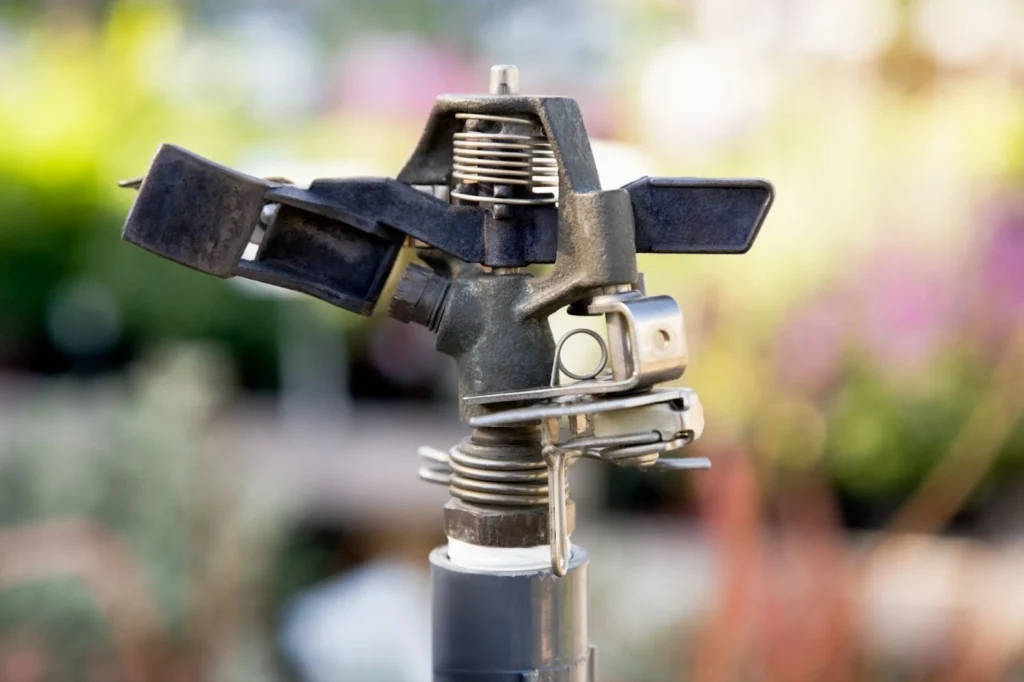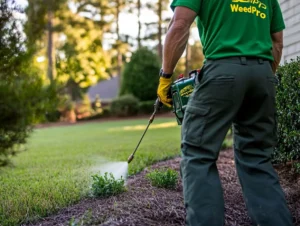Key Takeaways
- Small sprinkler issues, like a weak spray or a soggy patch, are often early warnings of leaks, pressure problems, or failing parts.
- A simple monthly walkthrough can catch head clogs, low pressure, controller glitches, and hidden leaks before they damage your lawn or your wallet.
- Some fixes are safe DIY (cleaning nozzles, basic checks), but a pro best handles underground leaks and electrical/controller issues.
- Regular maintenance keeps Atlanta and North Georgia systems more efficient, extending equipment life and cutting down on water waste.
Why Catching Sprinkler Problems Early Matters
Once you’ve invested in a sprinkler system, keeping it healthy is just as important as installing it. Ignoring minor warning signs can lead to:
- Wasted water and higher bills
- Dead or thinning patches of turf
- Soil erosion or sink spots
- Damage to valves, controllers, and underground piping
In our hot, sometimes stormy North Georgia climate, a tuned-up system is key to keeping your lawn healthy without overusing water.
Common Sprinkler Symptoms and What They Usually Mean
Many sprinkler problems show up in your lawn before you ever see a broken part. Here’s how to read those clues.
| What You See | The Likely Culprit | What to Look For |
| Water pooling on the surface | Underground pipe | Damp, soggy spots in specific lawn areas |
| Weak, misty spray | Valve or pressure issue | A fine mist instead of a strong, direct stream |
| Dry patches in the lawn | Sprinkler head | Brown or yellow areas where the sprinkler should be watering |
| Nothing happens when it should | Controller or wiring | No sprinkler heads pop up or water sprays when the zone is supposed to run |
These patterns help you zero in on whether you’re dealing with leaks, low pressure, bad heads, or controller trouble before the problem escalates.
Leaks, Low Pressure, and Head Issues: Early Red Flags
Leak Warning Signs You Shouldn’t Ignore
Sprinkler leaks occur when water escapes from pipes, fittings, or seals rather than passing through the heads. Watch for:
- Saturated or muddy spots, even when the system is off
- A “sinking” or squishy circle around a head
- A meter that moves between cycles even though nothing is running
Catching leaks early helps prevent soil erosion, wasted water, and damage to the surrounding landscape.
What Low Water Pressure Looks Like in the Yard
Low pressure doesn’t always mean a city-wide issue; often it’s inside the system:
- Heads produce a fine mist instead of a solid, controlled stream
- Water doesn’t reach its intended radius
- Far edges of the zone look dry or thin
Possible causes: clogged filters, broken pressure regulators, partially closed or stuck valves, or line damage. Tackling pressure problems early keeps coverage even and prevents you from overcompensating with longer run times.
Spotting Sprinkler Head Problems Before They Spread
Heads are small but mighty and often the first thing to cause dry spots:
- Clogged nozzles from dirt, sand, or debris
- Bent risers or heads knocked out of alignment by mowers or foot traffic
- Heads that don’t fully pop up or don’t retract
Even a tiny clog can distort the spray pattern and leave underwater grass arcs. Regular checks and quick cleaning keep these little issues from turning into big bare patches.
A Simple DIY Diagnostic Routine for Your Sprinkler System

Before you assume the worst, walk through a quick, structured check. This helps you separate simple DIY fixes from problems that need a pro.
Four Steps to Diagnose Issues Early
- Check the Controller
- Confirm the display is on and readable.
- Verify the correct date, time, and programmed start times.
- Check for dead backup batteries or power-loss resets.
- Manually Run Each Zone
- Turn on zones one at a time from the controller.
- Watch for heads that don’t pop up, weak patterns, or obvious misalignment.
- Listen for Leaks
- As each zone runs, listen for hissing or dripping near valve boxes or along suspected lines.
- Pay attention to areas where the ground appears wet but there is no visible spray.
- Compare Water Meter Readings
- Take a meter reading before and after a short test cycle.
- If usage seems high, or you see movement when the system is off, you may have a hidden leak.
Doing this once a month during watering season helps you catch trouble while it’s still easy to fix.
Controller Issues and Uneven Watering Patterns
Signs Your Sprinkler Controller Needs Attention
Controller problems often show up as:
- Zones that never come on or come on at the wrong time
- Overlapping run times or unexplained extra cycles
- Blank screen, error codes, or unresponsive buttons
- Schedules that reset to the default after an outage
These symptoms usually point to wiring issues, dead batteries, or failing internal components. While basic reprogramming is a good DIY step, most electrical repairs are safer in professional hands.
How to Spot Uneven Watering and Dry Spots
Uneven watering usually creates easy-to-see patterns:
- Alternating wet and dry stripes along mowing lines
- Brown arcs at the far edges of a head’s reach
- One corner of the yard that never greens up as well as the rest
These are often caused by:
- Heads tilted or turned the wrong way
- Clogged or mismatched nozzles within the same zone
- Pressure variations that keep some heads from reaching full throw
Adjusting head alignment, replacing nozzles, or addressing pressure issues can usually restore balance.
DIY Checks You Can Safely Do at Home
There are several simple tasks most homeowners can handle comfortably before calling in backup.
Basic Checks to Try First
- Clean sprinkler nozzles
- Turn off the system.
- Remove nozzles and screens, rinse with clean water, reassemble, and test.
- Inspect visible piping and fittings
- Look for damp spots, corrosion, or obvious cracks on above-ground sections.
- Test valves via the controller
- Run each zone and listen for the distinct “click” as valves open and close.
These checks can solve many small problems, especially clogs and minor alignment issues, without needing specialized tools.
Checking and Cleaning Sprinkler Heads Properly
A quick head-cleaning session can dramatically improve coverage.
- Shut the system off at the controller.
- Unscrew the nozzle and filter/screen from each problem head.
- Rinse away grit, grass clippings, and mineral buildup.
- Reinstall, then run the zone and observe the pattern.
- Adjust the arc and distance according to your lawn layout (usually done with a small screwdriver on adjustable heads).
Make this part of your spring start-up and mid-season check to prevent chronic dry spots.
Testing Water Pressure and Flow in Your System
If you suspect a pressure issue:
- Remove a nozzle and attach a pressure gauge to that riser.
- Take one reading with the system off (static pressure) and one with the zone running (working pressure).
- Most residential systems are designed to operate in the 30–50 psi range, depending on the type of head.
Numbers outside that working range can point to clogged lines, partially closed valves, failing regulators, or supply issues. If readings are confusing or far off design specs, it’s a good moment to involve a professional.
When to Inspect Valves and Pipes Yourself—and When Not To
After you’ve cleaned heads and checked pressure, you may still see:
- Ongoing wet spots near valve boxes
- Moisture in the valves themselves
- No “click” sound when a zone should open
- Mysteriously damp ground where no heads are located
You can safely:
- Open valve boxes and look for obvious cracks or soaked wiring.
- Check that manual bleed screws and solenoids are not visibly damaged.
But if pipes are wet with no clear source, or valves are silent and unresponsive, it’s usually time to let an irrigation technician dig deeper—especially around buried lines and electrical components.
When It’s Time to Call a Sprinkler Professional
Some problems simply aren’t safe or practical as DIY projects.
Situations That Call for a Pro
- Suspected underground leaks beneath the lawn, walkways, or near foundations
- Electrical issues in the controller or field wiring
- Water pressure that stays low even after cleaning filters and heads
- Repeated controller resets, Error messages, or zones that won’t respond
Professionals use tools such as acoustic leak detectors, pressure-testing equipment, and specialized locators to find and fix problems without tearing up the whole yard.
Why Regular Irrigation Maintenance Is Worth It
Staying ahead of sprinkler problems offers several long-term advantages:
- Healthier lawn: Consistent, even watering supports strong root systems and better color.
- Lower water use: Fixing leaks and optimizing runtimes prevents waste and high bills.
- Longer equipment life: Clean, properly pressurized systems simply last longer.
- Fewer surprises: Regular checks mean fewer emergency repairs in the middle of summer.
For Atlanta and North Georgia homeowners, a well-maintained system is one of the best tools you have for balancing curb appeal with responsible water use.
Stay One Step Ahead of Sprinkler Troubles, Let Weed Pro Help

Your sprinkler system is the lifeline of your lawn, but even minor issues like a clogged nozzle, a weak zone, or a hidden leak can quickly turn into bare spots, stressed turf, and rising water bills.
At Weed Pro Lawn Care, our local irrigation technicians know exactly what to look for and how to fix problems before they get expensive. From worn-out valves and misaligned heads to underground leaks and controller upgrades, we can:
- Diagnose issues quickly
- Make precise, lasting repairs
- Set up preventative maintenance that keeps everything running smoothly
Ready for a healthier lawn and a more efficient sprinkler system? Contact Weed Pro today to schedule your sprinkler check-up and give your lawn the care it deserves.
FAQ
How often should you check your sprinkler system for problems?
During watering season, give your system a quick check about once a month. Walk each zone, watch for dry spots or pooling, and look for heads that aren’t popping up, turning correctly, or spraying evenly.
Can smart irrigation controllers detect sprinkler problems?
Many modern smart controllers can monitor flow and flag unusual patterns that may indicate leaks or stuck valves. They’re not a complete substitute for visual checks, but they’re a powerful early-warning tool. Weed Pro can help you upgrade and properly configure a smart controller if you’d like that extra layer of protection.
Next Up: Make Your Flower Beds Healthier and Weed-Free
Now that you know how to maintain your sprinkler system, continue your landscape care journey with “Effective Weed Control Methods for Vibrant Flower Beds: How to Prevent and Remove Weeds Safely.” You’ll learn practical steps to stop weeds before they take over.







